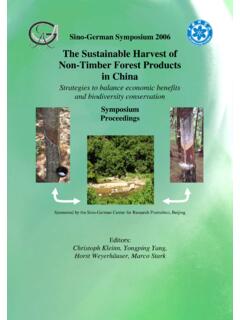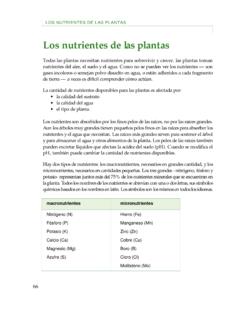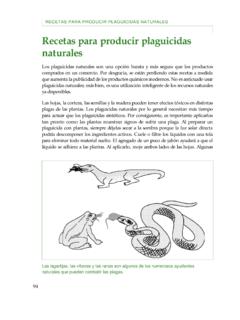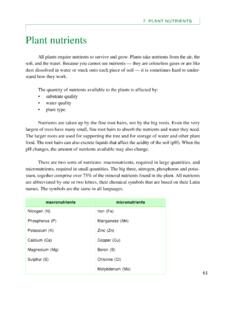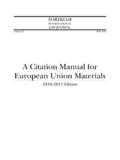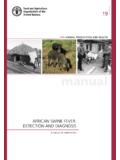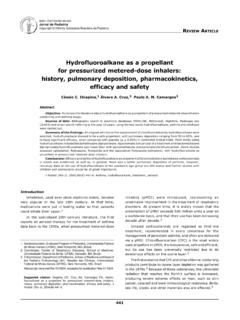Transcription of Growing Temperate Fruit Trees in Kenya Growing …
1 Growing Temperate Fruit Trees in KenyaGrowingTemperate Fruit Trees in KenyaJ rgen 11/30/08 1:29:34 PM51 Pear Growing Temperate Fruit Trees in KenyaJ rgen Gr esbachWorld AGroforestry Centre Growing Temperate Fruit Trees in KenyaPublished by World Agroforestry Centre (ICRAF) 2007 World Agroforestry Centre (ICRAF)P. O. Box 30677, Nairobi 00100 KenyaTel: +254 (20) 7224000 Fax: +254 (20) 7224001E-mail: of use: The copyright owner permits unrestricted use, distribution, and reproduction in any medium, except for commerical licensing and sale, provided the original author and source are citation: Griesbach J.
2 (2007) Growing Temperate Fruit Trees in Kenya . World Agroforestry Centre, Nairobi. Editors: Anthony J. Simons and Jan BeniestManuscript/Production Editor: Daisy Ouya, ELSD esigner/typesetter: SciTech Publishers ( Kenya ) : Kul Graphics ( Kenya ) : 978 92 9059 218 1 Cover photo: Apple cultivar Ana, J rgen GriesbachAll cultivar photos: J rgen GriesbachOther titles in this series:Griesbach J. (2003) Mango Growing in Kenya , World Agroforestry Centre, Nairobi. 117 J. (2005) Avocado Growing in Kenya , World Agroforestry Centre, Nairobi. 109 pp. ContentsForeword .. vTEMPERATE Fruit Trees IN Kenya .
3 1uses and Food Value ..2 Propagation .. 4 Dormancy and Climatic Conditions .. 5 Methods of Overcoming Dormancy .. 8 Orchard Establishment .. 10 Orchard Maintenance .. 13 Storage .. 24 Why Fruit Trees Fail to Bear .. 25 APPLEA pple (Malus domestica).. 28 History .. 28 Botany .. 28 Propagation .. 31 Major Pests of Apple .. 35 Important Diseases .. 35 Apple Cultivars .. 37 PEARPear (Pyrus communis; Pyrus serotina) .. 50 History .. 50 Botany .. 50 Propagation .. 52 Pear Cultivars .. 55 JAPANESE PLuMJapanese Plum (Prunus salicina) .. 68 History .. 68 Botany .. 68 Propagation.
4 69 Japanese Plum Cultivars .. 72 vvPEACHP each (Prunus persica) .. 84 History .. 84 Botany .. 86 Pests .. 88 Diseases .. 89 Peach Cultivars .. 90 Further Reading .. 98 Glossary of Terms .. 99 APPENDICES1. Temperate Fruit imports to Kenya , 2000 2003; 2005 .. 1012a. Production statistics for fresh horticultural produce, 1989 2005, Apple .. 1022b. Provincial apple production statistics, 1995 2005 .. 1033a. Production statistics for fresh horticultural produce, 1989 2005, Pear .. 1043b. Provincial pear production statistics, 1995 2005 .. 1054a. Production statistics for fresh horticultural produce, 1989 2005, Plum.
5 1064b. Provincial plum production statistics, 1995 2005 .. 1075a. Production statistics for fresh horticultural produce, 1989 2005, Peach .. 1085b. Provincial peach production statistics, 1998 2005 .. 1096. Recommended storage conditions and expected storage life of fresh Fruit ..1107. Altitude map of Kenya ..1118. The use of Cyanamide (Dormex ) as a chilling compensator in apple- Growing in Kenya ..1129. Space requirement for plants per hectare: Fruit orchards ..11410. Influence by soil reaction on the availability of plant nutrients ..11511. Some common and fully or provisionally registered Some common and fully or provisionally registered fungicides.
6 11813. Some common horticultural insecticides/fungicides and their recommended pre-harvest intervals ..12014. Production and export statistics summary 2003 2005 .. 12115. Export market statistics for deciduous fruits from Kenya in kilogrammes ..12316. Rootstock performance trial of selected apple cultivars .. 124 vvForewordGlobal production of Fruit has tripled over the past 40 years, with most of the increases being recorded in the Temperate regions. These production increases partly reflect rising demand, but there has also been a strong push from improved varieties and advances in Fruit tree husbandry.
7 Notwithstanding significant advances in some tropical fruits ( mangoes and avocados) the opportunities to grow, consume and export more Fruit from tropical regions remain under-exploited compared to Temperate regions. A somewhat surprising but often neglected aspect to addressing this imbalance is the cultivation of Temperate fruits in tropical regions. This volume describes the cultivation in Kenya of the world s four major Temperate fruits, namely apple, pear, plum and peach. Together, these fruits account for 15% of all world Fruit production, yet currently in the East African region they account for just a very small fraction of regional Fruit production.
8 The four key reasons identified through regional stakeholder surveys centre around (a) lack of awareness, (b) lack of elite planting materials and propagation knowledge, (c) lack of effective dissemination methods for cultivar multiplication and delivery, and (d) absence of market value chains. Growing Temperate Fruit Trees in Kenya will be highly instrumental in addressing the first two constraints, which are linked to market development. The author, who is an expert with more than 40 years of experience in horticulture in East Africa, including Kenya , uganda, Rwanda, Tanzania and Congo, brings a practical flair to a wide range of topics from the history of Temperate Fruit tree cultivation to botany, propagation, establishment and maintenance.
9 The recommendations, guidelines and illustrations in the book are the platform for the author s detailed varietal descriptions complemented by colour photographs of more than 50 varieties. Fruit preferences are as much of a cultural phenomenon as they are an agroclimatic or a physiological one. Even though most of the information on Temperate Fruit Growing contained in this publication is based on experiences gained in Kenya , a lot of it will also apply to highland areas in other East African countries. However, adaptive research will be needed to validate these recommendations in similar agroecological zones before embarking on large-scale production by smallholder or commercial growers.
10 We are confident that the practical information contained in this book will engender a greater Temperate Fruit Growing culture in East Africa. This in turn may benefit local household nutrition, rural incomes and export This book s production was made possible through grants of the Strengthening Institutions Programme of the Education and Development Division of The Netherlands Ministry of Foreign Affairs, the European Union, and Irish Aid. Their continuing support to the World Agroforestry Centre is greatly J. Simons, PhD Jan Beniest, IrPrincipal tree Scientist Principal Training Officer World Agroforestry Centre World Agroforestry Centre IntroductionTemperaTe Fruit Trees in KenyaThe cultivation of Temperate Fruit Trees in Kenya dates back to the arrival of European settlers who brought with them the species they grew and consumed in Europe.

